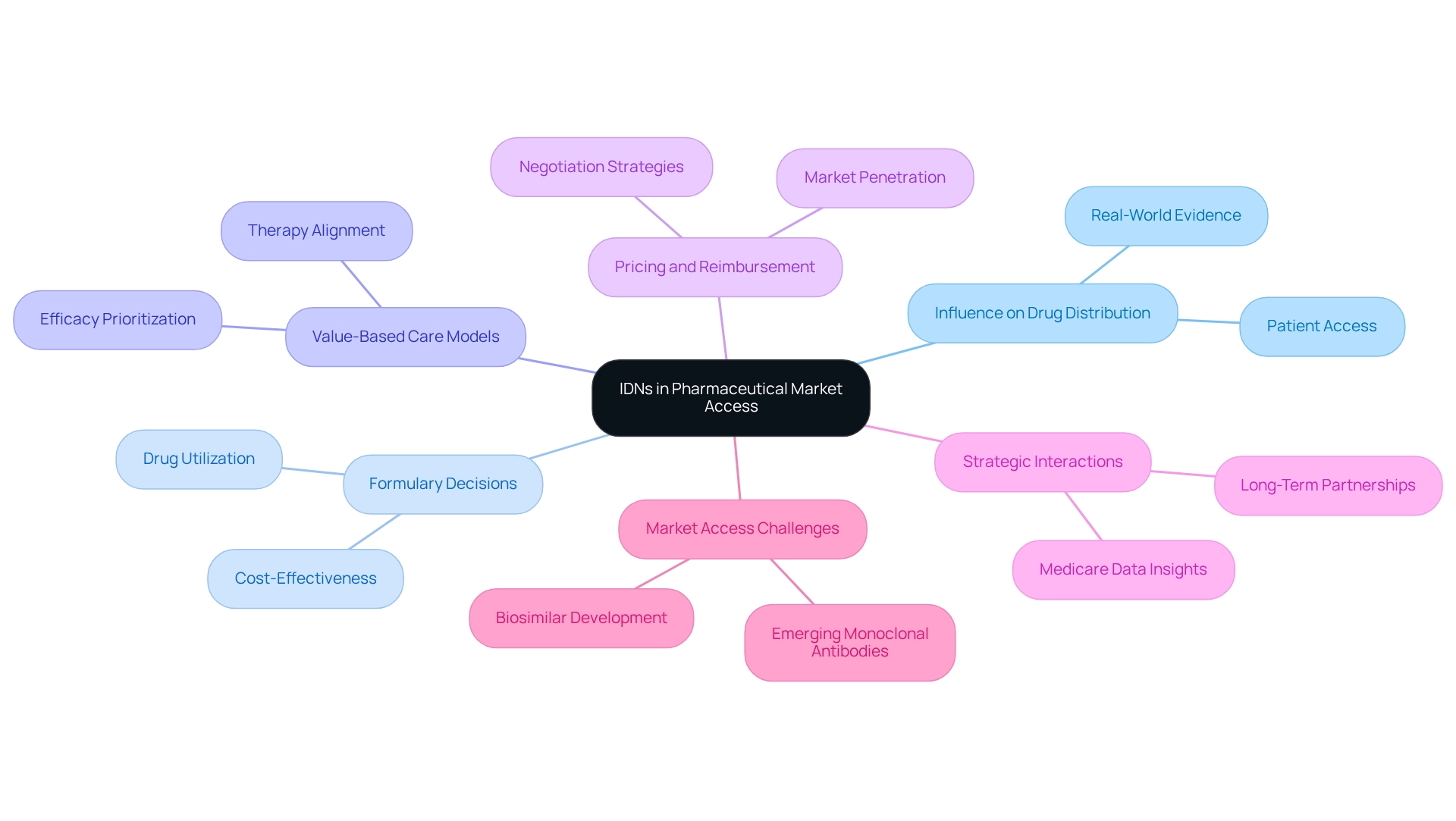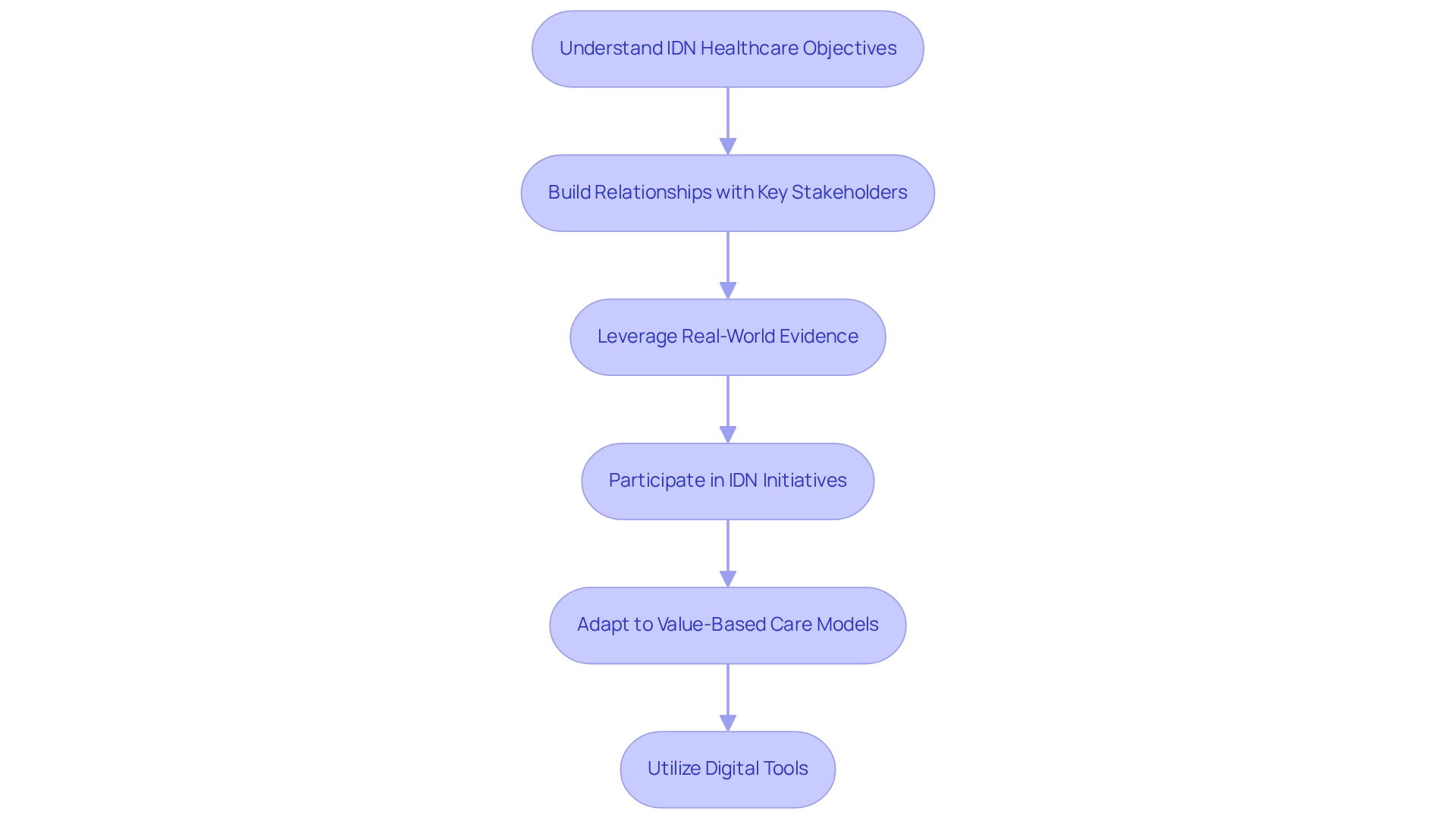Overview
Integrated Delivery Networks (IDNs) play a pivotal role in securing market access success within the healthcare sector. By uniting diverse providers, IDNs facilitate enhanced care coordination and significantly improve health outcomes.
It is essential for pharmaceutical companies to comprehend the intricacies of IDN structures and to engage with them through tailored strategies and real-world evidence. This understanding is vital for navigating the complex landscape of medication access and optimizing patient care.
As such, a strategic approach towards IDNs not only fosters collaboration but also drives better health results for patients.
Introduction
In the rapidly evolving landscape of healthcare, Integrated Delivery Networks (IDNs) are emerging as pivotal players, fundamentally transforming the delivery and management of patient care.
By uniting various healthcare providers—from hospitals to outpatient facilities—under a cohesive framework, IDNs enhance coordination and streamline care delivery, ultimately leading to improved health outcomes.
The significance of these networks is increasingly pronounced, particularly as they influence pharmaceutical market access and treatment pathways.
As stakeholders navigate the complexities of this integrated care model, understanding the dynamics of IDNs is crucial for optimizing patient outcomes and ensuring effective engagement with the healthcare ecosystem.
Define Integrated Delivery Networks (IDNs) in Healthcare
Integrated Delivery Networks represent a transformative approach in healthcare, uniting various providers—such as hospitals, outpatient facilities, and physician groups—under a cohesive organizational framework. This integration in IDN healthcare is designed to simplify treatment, enhance service provision, and improve health outcomes by promoting coordination across multiple levels of support. By enabling a continuous system of support, IDN healthcare ensures that individuals receive comprehensive treatment from a network of providers, which not only boosts efficiency but also enhances the management of individual data and resources. Consequently, satisfaction among individuals and health outcomes are significantly improved.
Recent advancements in 2025 indicate that approximately 80.1% of individuals with Major Depressive Disorder (MDD) and 75.7% of those without MDD are linked to IDN healthcare, underscoring the growing presence of these networks in individual care. Notably, the use of antidepressants was low in the non-MDD group, with only 2% utilizing SNRIs, highlighting the treatment landscape within IDN healthcare networks. The economic burden associated with treatment-resistant depression (TRD) is substantial, primarily driven by non-behavioral health-related expenses, which emphasizes the critical role of IDN healthcare in addressing the complex needs of individuals.
CareSet’s advanced Medicare data analytics provide essential insights into these networks, revealing provider connections and treatment pathways that enhance individual experiences. Specialist perspectives accentuate the benefits of integrated delivery networks in improving healthcare outcomes. For instance, successful IDN healthcare models have demonstrated effective care coordination, leading to improved health outcomes and reduced costs. A statistical analysis of groups, employing propensity score matching, indicated that after matching treatment-resistant individuals with non-treatment-resistant MDD and non-MDD individuals, the groups were well-balanced on demographic factors, facilitating a more accurate comparison of healthcare utilization and costs.
In 2025, the landscape of integrated delivery networks in IDN healthcare continues to evolve, with a significant number of healthcare providers participating in these networks across the United States. Understanding the structure and role of integrated delivery networks is vital for pharmaceutical companies aiming to engage effectively with IDN healthcare systems and leverage their influence in the healthcare market. By recognizing the importance of IDN healthcare, stakeholders can develop strategies that align with the integrated care model, ultimately enhancing market access and improving outcomes for individuals.

Explore the Role of IDNs in Pharmaceutical Market Access
Integrated delivery networks (IDNs) are essential participants in the pharmaceutical market access landscape, significantly influencing the distribution and utilization of medications within their systems. They wield considerable influence over drug formulary decisions, ultimately determining patient access to various treatments. As IDNs increasingly embrace value-based care models, there is a pronounced shift towards prioritizing therapies that demonstrate both efficacy and cost-effectiveness. This evolution compels drug companies to align their offerings with the goals of IDNs, emphasizing real-world evidence and outcomes that resonate with these systems.
Furthermore, IDNs frequently lead discussions on pricing and reimbursement conditions with manufacturers. Understanding the unique needs and preferences of each IDN is crucial for pharmaceutical companies aiming to secure favorable access for their products. Successful interactions with IDNs can enhance access to medications for individuals and improve market penetration.
Statistics indicate that over 80% of brand biologics suitable for competition currently lack biosimilars in progress, underscoring the essential requirement for strategic interaction with IDNs to navigate this competitive environment. Case studies, such as the transformation of MARIN into a strategic insight leader in oncology market access, illustrate how organizations can evolve to meet the complexities of market access through a deep understanding of IDN dynamics. Moreover, utilizing extensive Medicare data insights, as demonstrated in CareSet’s case studies, empowers healthcare stakeholders to make informed choices that enhance care and optimize medication strategies.
As IDNs continue to shape the market access landscape in the drug industry, their impact on medication formulary choices will only increase. It is imperative for companies in the sector to adjust their strategies accordingly. By leveraging actionable insights from Medicare claims data and fostering strong connections with IDNs, companies can enhance patient access and refine their market strategies. As Judita Perndrecaj noted, “This conference acted as a significant platform for knowledge sharing and impacting the advancement of the medicine sector to ensure improved healthcare for everyone,” emphasizing the importance of teamwork and strategic involvement in this evolving environment. Furthermore, the emergence of a new generation of monoclonal antibodies (mAbs) introduces unique challenges that necessitate innovative approaches, highlighting the need for IDNs to adapt and for drug companies to remain flexible in their market access strategies.

Implement Strategies for Engaging with IDNs
To effectively interact with integrated delivery networks, pharmaceutical companies should adopt a multi-faceted approach that includes several critical strategies.
First, it is essential to understand IDN healthcare objectives. Conduct thorough research to comprehend the specific goals and challenges faced by the IDN. This knowledge will enable you to tailor your value proposition to align seamlessly with their priorities.
Next, building relationships with key stakeholders is paramount. Identify and connect with decision-makers within IDN healthcare, including physicians, pharmacists, and administrative leaders. Establishing trust and rapport is crucial for effective collaboration.
Moreover, leveraging real-world evidence is vital. Utilize CareSet’s comprehensive healthcare data insights, which analyze over $1.1 trillion in annual Medicare claims, including drug utilization and treatment pathways. Presenting compelling evidence of your products’ effectiveness and cost-efficiency can significantly influence decision-making, especially as organizations increasingly focus on outcomes.
Additionally, participating in IDN healthcare initiatives can further enhance your engagement. Engage in programs or initiatives led by IDNs that aim to improve treatment or operational efficiency. This involvement positions your company as a valuable partner in their efforts.
It is also important to adapt to value-based care models. Align your product offerings and messaging with the principles of value-based care, emphasizing how your products can enhance health outcomes and reduce overall healthcare expenses, supported by insights from CareSet’s monthly Medicare updates.
Lastly, utilize digital tools to facilitate ongoing communication. Implement digital engagement strategies, such as virtual meetings and online resources, to provide continuous support to stakeholders in IDN healthcare. By employing these strategies, pharmaceutical companies can significantly enhance their engagement with IDN healthcare, ultimately leading to improved market access and better patient outcomes. Explore how CareSet’s innovative Medicare data solutions can empower your business for data-driven success.

Conclusion
The emergence of Integrated Delivery Networks (IDNs) signifies a transformative shift in the healthcare landscape, fundamentally changing how patient care is delivered and managed. By integrating diverse healthcare providers, IDNs cultivate a collaborative environment that enhances coordination, streamlines care, and ultimately leads to improved health outcomes. As evidenced by the data and case studies presented, IDNs not only enhance patient satisfaction but also address complex needs, particularly in areas such as treatment-resistant depression.
In the context of pharmaceutical market access, IDNs play an essential role in shaping drug formulary decisions and determining patient access to medications. Their influence grows as they adopt value-based care models, compelling pharmaceutical companies to align their strategies with the objectives of these networks. Effectively engaging with IDNs—through an understanding of their goals, relationship building, leveraging real-world evidence, and adapting to evolving healthcare paradigms—can significantly enhance market access and patient care.
As IDNs continue to evolve and expand their influence, it is crucial for stakeholders in the healthcare ecosystem to acknowledge their pivotal role. By prioritizing collaboration and strategic engagement, pharmaceutical companies can navigate the complexities of IDNs and contribute to a healthcare system that emphasizes patient outcomes and operational efficiency. Embracing this integrated approach not only benefits individual patients but also strengthens the healthcare landscape as a whole, ensuring that all stakeholders can thrive in this new era of care delivery.


